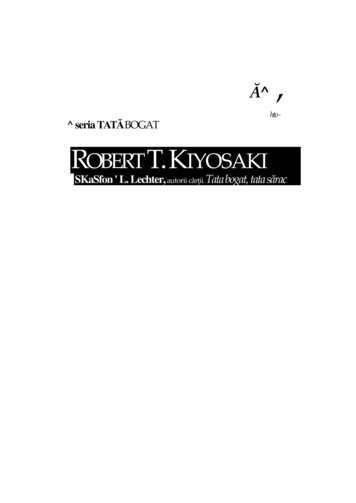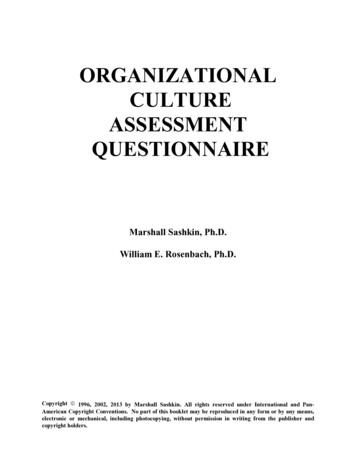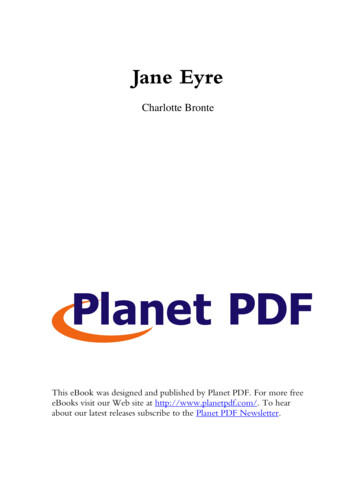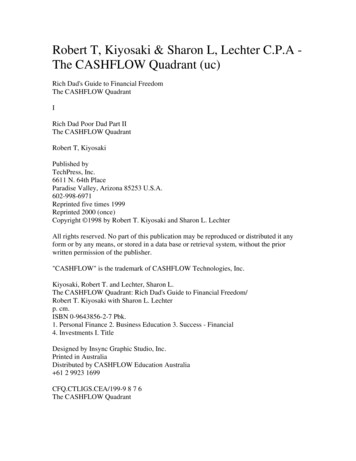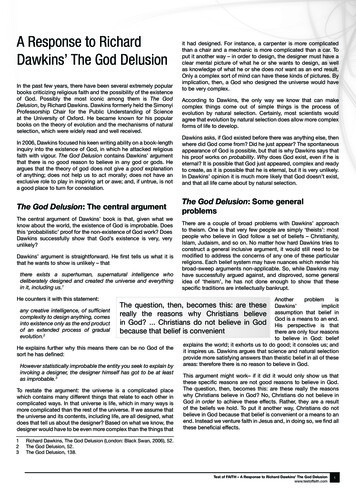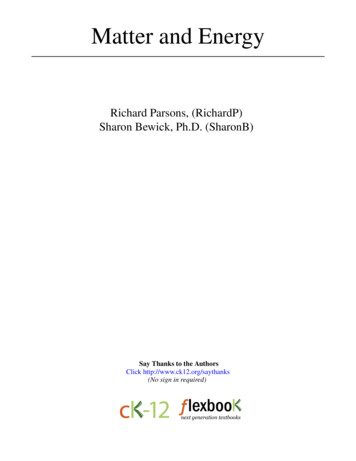
Transcription
Matter and EnergyRichard Parsons, (RichardP)Sharon Bewick, Ph.D. (SharonB)Say Thanks to the AuthorsClick http://www.ck12.org/saythanks(No sign in required)
To access a customizable version of this book, as well as otherinteractive content, visit www.ck12.orgAUTHORSRichard Parsons, (RichardP)Sharon Bewick, Ph.D. (SharonB)EDITORShonna Robinson, (ShonnaR)CK-12 Foundation is a non-profit organization with a mission toreduce the cost of textbook materials for the K-12 market bothin the U.S. and worldwide. Using an open-content, web-basedcollaborative model termed the FlexBook , CK-12 intends topioneer the generation and distribution of high-quality educationalcontent that will serve both as core text as well as provide anadaptive environment for learning, powered through the FlexBookPlatform .Copyright 2013 CK-12 Foundation, www.ck12.orgThe names “CK-12” and “CK12” and associated logos and theterms “FlexBook ” and “FlexBook Platform ” (collectively“CK-12 Marks”) are trademarks and service marks of CK-12Foundation and are protected by federal, state, and internationallaws.Any form of reproduction of this book in any format or medium,in whole or in sections must include the referral attribution linkhttp://www.ck12.org/saythanks (placed in a visible location) inaddition to the following terms.Except as otherwise noted, all CK-12 Content (includingCK-12 Curriculum Material) is made available to Usersin accordance with the Creative Commons Attribution/NonCommercial/Share Alike 3.0 Unported (CC BY-NC-SA) sa/3.0/), as amendedand updated by Creative Commons from time to time (the “CCLicense”), which is incorporated herein by this reference.Complete terms can be found at http://www.ck12.org/terms.Printed: August 19, 2013
www.ck12.orgChapter 1. Matter and EnergyC HAPTER1Matter and EnergyC HAPTER O UTLINE1.1What is Matter?1.2Properties and Changes of Matter1.3Energy1.4References1
1.1. What is Matter?www.ck12.org1.1 What is Matter?Lesson ObjectivesThe student will: define matter and explain how it is composed of building blocks known as atoms.explain the differences between substances and mixtures.classify mixtures as homogeneous or heterogeneous.identify the chemical symbols of common elements.explain the difference between an element and a compound by their symbols or formulas.demonstrate the proper use of parentheses and subscripts in writing chemical formulas.determine the number of atoms and name of each element in a compound.Vocabularyatomthe basic building block of all mattercompounda pure substance that is made up of more than one type of atomelementa pure substance that is made up of only one type of atomheterogeneous mixturea mixture that consists of visibly different substanceshomogeneous mixturea mixture that is uniform throughoutlaw of constant compositionlaw that states that the ratio by mass of the elements in a chemical compound is always the same, regardlessof the source of the compoundmatteranything that has mass and volumemoleculethe smallest particle of a compound2
www.ck12.orgChapter 1. Matter and EnergyIntroductionMatter is anything that has mass and volume. The entire universe is composed of matter, which is in turn composedof atoms. An atom is the basic building block of all matter. All matter in the universe, from a teaspoon of salt tothe Pacific Ocean, has mass and occupies space. The salt and ocean, however, have very different properties andbehaviors. Since everything in the universe is composed of matter, there are clearly many types of matter. In thislesson, you will learn about how scientists classify the different types of matter.Categories of MatterMatter can be classified into two broad categories: mixtures and pure substances, as illustrated below.Mixtures are physical combinations of two or more substances. The term “physical combination” refers to mixingtogether different substances that do not chemically react with each other. The physical appearance of the substancesmay change, but the atoms in the substances do not.In comparison, a pure substance is a form of matter that has a constant composition and constant properties throughout the sample. Elements and compounds are both example of pure substances.Mixtures: Homogeneous and HeterogeneousOne example of a mixture is sand and gravel stirred together. In this case, you can see that there are two differentsubstances present, each with the same properties that it had before it was mixed. When substances do not mixthoroughly and evenly (like sand and gravel), the mixture is said to be heterogeneous. A heterogeneous mixtureconsists of visibly different substances.Another example of a mixture is salt dissolved in water. In this case, you cannot see the different substances, butyou can test the solution to show that each substance (salt and water) has the same chemical properties it had beforebeing mixed. When substances mix thoroughly and evenly (like salt in water), the mixture is said to be homogeneous.Homogeneous mixtures are often referred to as solutions. Solutions often may appear to be one pure substance, butsome simple tests can show that the solutions are indeed mixtures.Pure Substances: Elements and CompoundsElements are the simplest substances. An element is a substance that is made up of only one type of atom. It doesn’tmatter if the atoms are in groups, as in P4 or S8 , or isolated, as in Na. As long as there is only one kind of atom,the substance is an element. Elements cannot be chemically broken down into anything smaller and still retain the3
1.1. What is Matter?www.ck12.orgproperties of the element. For example, an atom of iron can be smashed into electrons, protons, and neutrons, butthose pieces would not have the properties of iron.Atoms from two or more elements can chemically combine to form a new substance. Compounds are substancesthat are made up of more than one type of atom. In other words, compounds are chemical combinations of elements.These combinations form new substances with completely different properties than the atoms from which they wereformed.The image above is a model of water. Water is a compound consisting of one atom of oxygen and two atoms ofhydrogen. Hydrogen is an explosive gas, and oxygen is a gaseous substance that supports combustion. Yet, whenthese two elements are chemically combined to form water, the product neither burns nor supports combustion. Infact, water is used to put out fires.A molecule is the smallest particle of a compound. If you break up the molecule, you no longer have the propertiesof the compound. Molecules, like atoms, are too small to be seen. Even with the most powerful microscopes, wehave only seen the very largest of molecules.The illustration above shows a single unit of the compound called sodium chloride on the left. This single unit ismade up of one sodium ion and one chloride ion. Sodium is a very reactive metal that explodes in water and burnsin air, while chlorine is a very deadly, poisonous gas. When these two are combined, we get table salt (sodiumchloride). When sodium chloride is in solid form, many units join together, as illustrated above on the right.Elements: Names and SymbolsEverything, from ants to galaxies, is composed of atoms. So far, scientists have discovered or created 118 differenttypes of atoms. Scientists have given a name to each different type of element and organized them into a chart calledthe periodic table. As you can see in the table below, each square contains one of the elements.4
www.ck12.orgChapter 1. Matter and EnergyEach element not only has its own name, it also has its own symbol. Scientists use abbreviations called chemicalsymbols to represent the elements. Many of these symbols are the first one or two letters of the modern name of theelement. The first letter of a chemical symbol must always be a capital letter, and the second letter, when there is asecond letter, must always be a lowercase letter. Table 1.1 shows some examples of elements and their symbols.TABLE 1.1: Examples of SymbolHOCCaAlAs seen in Table 1.2, the symbols for some of the elements consist of the first letter of the name and another letter(not the second letter) that comes later in the name.TABLE 1.2: More Examples of umSymbolZnMgClAsZr5
1.1. What is Matter?www.ck12.orgFor other elements, the symbols were already used for other elements. When trying to decide on a symbol for silver,for example, the symbol S was already used for sulfur, and the symbol Si was already used for silicon. Since silverhas been known to man for over a thousand years, it had a Latin name from ancient times. The old Latin namefor silver was argentum, so it was decided that the symbol for silver would be Ag. There are a number of symbolschosen in this same manner, as seen in Table 1.3.TABLE 1.3: Examples of Elements Whose Symbol Comes from nAncient ymbolAgKNaAuPbCuFeCompounds: Chemical FormulasThe chemical symbols are not only used to represent the elements, they are also used to write chemical formulas forthe millions of different compounds. For a given chemical compound, the law of constant composition states thatthe ratio by mass of the elements in the compound is always the same, regardless of the source of the compound.The law of constant composition can be used to distinguish between compounds and mixtures. Compounds havea constant composition, and mixtures do not. Pure water is always 88.8% oxygen and 11.2% hydrogen by weight,regardless of the source of the water. Brass is an example of a mixture. Brass consists of two elements, copper andzinc, but it can contain as little as 10% or as much as 45% zinc.The formula for a compound uses the symbols to indicate the type of atoms involved and uses subscripts to indicatethe number of each atom in the formula. For example, aluminum combines with oxygen to form the compoundaluminum oxide. Forming aluminum oxide requires two atoms of aluminum and three atoms of oxygen. Therefore,we write the formula for aluminum oxide as Al2 O3 . The symbol Al tells us that the compound contains aluminum,and the subscript 2 tells us that there are two atoms of aluminum in each molecule. The O tells us that the compoundcontains oxygen, and the subscript 3 tells us that there are three atoms of oxygen in each molecule. It was decidedby chemists that when the subscript for an element is 1, no subscript needs to be used. Thus the chemical formulaMgCl2 tells us that one molecule of this substance contains one atom of magnesium and two atoms of chlorine. Theformula for sodium chloride is NaCl, which indicates that the compound contains one atom each of sodium andchlorine. The formula for sodium carbonate, Na2 CO3 , indicates that there are two atoms of sodium, one atom ofcarbon, and three atoms of oxygen. In formulas that contain parentheses, the subscript outside of the parenthesesapplies to everything inside. For example, the subscript 2 in Ca(OH)2 , the subscript 2 applies to the (OH). Therefore,this molecule of calcium hydroxide contains one atom of calcium, two atoms of oxygen, and two atoms of hydrogen.Lesson Summary All matter has mass and occupies space. Matter can be classified into two broad categories: pure substances and mixtures. A pure substance is a form of matter that has constant composition and constant properties throughout thesample. Mixtures are physical combinations of two or more substances. Elements and compounds are both example of pure substances. Compounds are substances that are made up of more than one type of atom.6
www.ck12.org Chapter 1. Matter and EnergyElements are the simplest substances made up of only one type of atom.The elements are organized into a chart called the periodic table.Scientists use abbreviations called chemical symbols to represent the elements.The first letter of a chemical symbol is capitalized, and the second letter is not.Further Reading / Supplemental LinksYou may listen to Tom Lehrer’s humorous song “The Elements” with animation at this website. http://www.privatehand.com/flash/elements.htmlThis website provides a review about matter and the categories of matter. htmlReview Questions1. Pure substances contain only one type ofa.b.c.d.atoms only.molecules only.atoms or molecules.mixture.2. What type of mixture produces the same properties for every sample of the environmental3. Which of the following is a heterogeneous mixture?a.b.c.d.pure golddistilled waterheliummilk4. Which of the following is not a heterogeneous mixture?a.b.c.d.concretepizzasugar watersoup5. If you can easily see the different parts that make up a mixture, you know that it is a bleplasma6. What do we call a material that is composed of two or more pure substances?a. a compound7
1.1. What is Matter?b. an elementc. a mixtured. a heterogeneous mixture7. Identify the following mixtures as homogeneous or heterogeneous.a. brassb. sugar dissolved in waterc. vegetable soup8. Identify which of the following pure substances are elements and which are compounds.a. table saltb. oxygenc. water9. A pure substance composed of two or more elements chemically combined is aa.b.c.d.homogeneous mixture.compound.element.heterogeneous mixture.10. The smallest piece of a compound that still has all the properties of the compound is a(n)a.b.c.d.atom.formula.mixture.molecule.11. Identify the elements involved in the compound H2 SO4 .12. How many phosphorus atoms are present in one molecule of H3 PO4 ?8www.ck12.org
www.ck12.orgChapter 1. Matter and Energy1.2 Properties and Changes of MatterLesson ObjectivesThe student will: explain the difference between physical and chemical properties of matter.list examples of physical properties.list examples of chemical properties.classify properties as chemical properties or physical properties.explain the difference between physical and chemical changes in matter.list examples of physical changes.list examples of chemical changes.classify changes as physical changes or chemical changes.Vocabularychemical changechange that occurs when one substance is turned into another substancechemical propertyproperty that can be observed only when a substance is changed into a new substancephysical changechange that does not alter the identity of a substancephysical propertyproperty that can be observed without changing the identity of the substanceIntroductionWhat kinds of properties do chemists actually measure in the laboratory? Well, you can probably guess a few.Imagine that you are having dinner at a friend’s house and are served something that you don’t recognize. Whattypes of observations might you make to determine what you’ve been given? You might note the smell or color ofthe food. You might observe whether the food is a liquid or a solid. You could also pick up a small amount of foodwith your fork and try to figure out how much it weighs. A light dessert might be something like an angel cake,while a heavy dessert is probably a pound cake. You might also want to know something about the food’s texture.Is it hard and granular like sugar cubes, or soft and easy to spread like butter?Believe it or not, the observations you are likely to make when trying to identify an unknown food are very similar tothe observations that a chemists makes when trying to learn about a new material. In general, chemists are interested9
1.2. Properties and Changes of Matterwww.ck12.orgin characteristics that you can test and observe, such as a chemical’s smell or color, and characteristics that are fartoo small to see, such as what the oxygen you breathe in or the carbon dioxide you breathe out looks like. Chemistsrely on color, state (solid, liquid, or gas), temperature, volume, mass, and texture. There is, however, one propertyyou might use to learn about a food but that you should definitely not use to learn about a chemical – taste!Physical and Chemical PropertiesThere are two basic types of properties that are used to identify or describe matter: physical properties and chemicalproperties. Physical properties are properties that can be observed without changing the identity of the substance.In the image below, we have water molecules that are held in liquid form on the left. Each molecule containstwo atoms of hydrogen chemically bounded with one atom of oxygen. When we heat the liquid water, it changes towater vapor. The physical properties change - we can see the liquid water, but the water vapor cannot be seen. Liquidwater has a higher density than water vapor, and so on. But even though the physical properties have changed, themolecules are exactly the same as before. Each water molecule still contains two hydrogen atoms and one oxygenatom chemically bounded together.On the other hand, chemical properties can only be observed when a substance is changed into a new substance.In the image below, on the left we have a molecule of methane (CH4 ) and two molecules of oxygen (O2 ). On theright, we have two molecules of water (H2 O) and one molecule of carbon dioxide (CO2 ). In this case, not only hasthe appearance changed, but the structures of the molecules have also changed. The new substances do not have thesame chemical properties as the original ones. Therefore, this is a chemical change. The chemical properties, suchas how they react and what they react with, however, will still be the same as before.10
www.ck12.orgChapter 1. Matter and EnergyPhysical and Chemical ChangesChemists make a distinction between two different types of changes that they study: physical changes and chemicalchanges. Physical changes are changes that do not alter the identity of a substance. Some types of physical changesinclude: changes of state (changes from a solid to a liquid or a gas, and vice versa)separation of a mixturephysical deformation (cutting, denting, stretching)making solutions (special kinds of mixtures)If you have a jar containing a mixture of pennies and nickels and you sort the mixture so that you have one pile ofpennies and another pile of nickels, you have not altered the identity of either the pennies or the nickels. You’vemerely separated them into two groups. Similarly, if you have a piece of paper and you rip it up, you don’t changethe paper into something other than a piece of paper. These are examples of a physical change. For the most part,physical changes tend to be reversible, or capable of occurring in both directions. You can turn liquid water intosolid water (ice) through cooling, and you can also turn solid water into liquid water through heating (Figure 1.1).FIGURE 1.1Melting snow is an example of a physical change.Chemical changes are changes that occur when one substance is turned into another substance. Chemical changesare frequently harder to reverse than physical changes. One good example of a chemical change is burning paper.In contrast to the act of ripping paper, the act of burning paper actually results in the formation of new chemicals(carbon dioxide and water, to be exact). Notice that whereas ripped paper can be at least partially reassembled,burned paper cannot be “unburned.” In other words, burning only goes in one direction. The fact that burning isnot reversible is another good indication that it involves a chemical change. Another example of a chemical change,illustrated in Figure 1.2, is the explosion of fireworks.Lesson Summary There are two basic types of properties that are used to identify or describe matter: physical properties andchemical properties. Physical properties are those that can be observed without changing the identity of the substance. Chemical properties are those that can be observed only when a substance is changed into a new substance.11
1.2. Properties and Changes of Matterwww.ck12.orgFIGURE 1.2Fireworks are an example of a chemical change. Chemists make a distinction between two different types of changes that they study: physical changes andchemical changes. Physical changes are changes that do not alter the identity of a substance Chemical changes are changes that occur when one substance is turned into another substance. Chemical changes are frequently harder to reverse than physical changes.Further Reading / Supplemental LinksThis website provides some free PowerPoint presentations. The presentation on “Matter and Energy" provides areview of some properties of matter, as well as provide examples of the topics covered in this lesson. http://science.pppst.com/energy.htmlThis website has lessons, worksheets, and quizzes on various high school chemistry topics. Lesson 1-5 is on physicaland chemical properties, as well as physical and chemical changes. /lesson15.htmReview QuestionsFor questions 1-2, determine whether the description is of a physical property or a chemical property.1. Water boils at 100 C.a. This is a physical property.b. This is a chemical property.2. Diamonds will cut glass.a. This is a physical property.b. This is a chemical property.For questions 3-7, determine whether the description is of a physical change or a chemical change.3. Water can be separated by electrolysis into hydrogen gas and oxygen gas.a. This is a physical change.b. This is a chemical change.4. Sugar dissolves in water.12
www.ck12.orgChapter 1. Matter and Energya. This is a physical change.b. This is a chemical change.5. Vinegar and baking soda react to produce a gas.a. This is a physical change.b. This is a chemical change.6. Yeast acts on sugar to form carbon dioxide and ethanol.a. This is a physical change.b. This is a chemical change.7. Wood burns, producing several new substances.a. This is a physical change.b. This is a chemical change.13
1.3. Energywww.ck12.org1.3 EnergyLesson ObjectivesThe student will: explain the difference between kinetic and potential energy.state the law of conservation of matter and energy.define heat.define work.Vocabularychemical potential energyenergy stored in the atoms, molecules, and chemical bonds that make up matterenergyis the ability to do work or cause changekinetic energyenergy associated with motionlaw of conservation of energystates that energy cannot be created or destroyed, it can only be changed from one form to anotherlaw of conservation of matter and energystates that the total amount of mass and energy in the universe is conserved (does not change)potential energystored energyworkforce (any push or pull) applied over a distanceIntroductionJust like matter, energy is a term that we are all familiar with and use on a daily basis. Before you go on a long hike,you eat an energy bar; every month, the energy bill is paid; on TV, politicians argue about the energy crisis. But haveyou ever wondered what energy really is? If you stop to think about it, energy is very complicated. When you plug14
www.ck12.orgChapter 1. Matter and Energya lamp into an electric socket, you see energy in the form of light, but when you plug a heating pad into that samesocket, you only feel warmth. Without energy, we couldn’t turn on lights, we couldn’t brush our teeth, we couldn’tmake our lunch, and we couldn’t travel to school. In fact, without energy, we couldn’t even wake up because ourbodies require energy to function. We use energy for every single thing that we do, whether we’re awake or asleep.Although we all use energy, very few of us understand what it is.Types of Energy: Kinetic and PotentialEnergy is the ability to do work or cause change. Machines use energy, our bodies use energy, energy comes fromthe sun, energy causes forest fires, and energy helps us to grow food. With all these seemingly different types ofenergy, it’s hard to believe that there are really only two different forms of energy: kinetic energy and potentialenergy.Kinetic energy is energy associated with motion. When an object is moving, it has kinetic energy, and when theobject stops moving, it has no kinetic energy. Although all moving objects have kinetic energy, not all movingobjects have the same amount of kinetic energy. The amount of kinetic energy possessed by an object is determinedby its mass and its speed. The heavier an object is and the faster it is moving, the more kinetic energy it has.Kinetic energy is very common and is easy to spot in the world around you. Sometimes we even capture kineticenergy and use it to power things like our home appliances. Have you ever seen windmills lining the slopes of a hilllike the ones in Figure 1.3? These windmills capture the kinetic energy of the wind to provide power that peoplecan use in their homes and offices. As wind rushes along the hills, the kinetic energy of the blowing air particlesturns the windmills, which convert the wind’s kinetic energy into electricity.FIGURE 1.3This is a photograph of a wind farm inSouthern California. Kinetic energy fromthe rushing air particles turns the windmills, allowing us to capture the wind’skinetic energy and use it.Capturing kinetic energy can be very effective, but you may already realize that there is a small problem: kineticenergy is only available when something is moving. When the wind stops blowing, there’s no kinetic energyavailable. Imagine what it would be like trying to power your television set using the wind’s kinetic energy. Youcould turn on the TV and watch your favorite program on a windy day, but every time the wind stopped blowing,your TV screen would flicker off because it would run out of energy.You’d have noticed, however, that you can usually rely on your TV to stay on. This is largely because we don’t rely15
1.3. Energywww.ck12.orgon kinetic energy alone for power. Instead, we primarily use energy in its other form as potential energy. Potentialenergy is stored energy that remains available until we choose to use it. Think of a battery in a flashlight. If you leavea flashlight on, the battery will run out of energy within a couple of hours. If, instead, you only use the flashlightwhen you need it and turn it off when you don’t, the battery will last for days or even months. Because the batterystores potential energy, you can choose to use the energy all at once, or you can save it and use a small amount at atime.Any stored energy is potential energy and has the “potential” to be used at a later time. Unfortunately, there are alot of different ways in which energy can be stored, making potential energy very difficult to recognize. Generallyspeaking, an object has potential energy due to its position relative to another object. For example, when you hold arock above the earth, it has more potential energy than a rock on the ground. As long as you’re holding the rock, therock has potential energy stored. Once you drop the rock, though, the stored energy is released. This can confusestudents because it doesn’t seem like a falling rock is releasing energy. Remember, however, that energy is definedas the ability to do work or cause change.For some examples of potential energy, though, it’s harder to see how “position” is involved. In chemistry, we areoften interested in what is called chemical potential energy. Chemical potential energy is energy stored in theatoms, molecules, and chemical bonds that make up matter. How does this depend on position? As you learnedearlier, the world and all of the chemicals in it are made up of atoms. These atoms store potential energy that isdependent on their positions relative to one another. Although we cannot see atoms, scientists know a lot aboutthe ways in which atoms interact. This allows them to figure out how much potential energy is stored in a specificquantity of a particular chemical. Different chemicals have different amounts of potential energy because they aremade up of different atoms, and those atoms have different positions relative to one another.The image below represents two hydrogen atoms chemically joined to an oxygen atom to form a water molecule.Scientists use their knowledge of what the atoms and molecules look like and how they interact to determine thepotential energy that can be stored in any particular chemical substance.Since different chemicals have different amounts of potential energy, scientists will sometimes say potential energydepends on not only position but also composition. Composition affects potential energy because it determineswhich molecules and atoms end up next to each other. For example, the total potential energy in a cup of pure wateris different than the total potential energy in a cup of apple juice because the cup of water and the cup of apple juiceare composed of different amounts of different chemicals.16
www.ck12.orgChapter 1. Matter and EnergyThe Law of Conservation of Matter and EnergyWhile it’s important to understand the difference between kinetic energy and potential energy, the truth is energyis constantly changing. Kinetic energy is constantly being turned into potential energy, and potential energy isconstantly being turned into kinetic energy. Even though energy can change form, it must still follow the fundamentallaw: energy cannot be created or destroyed, it can only be changed from one form to another. This law is knownas the law of conservation of energy. In a lot of ways, energy is like money. You can exchange quarters for dollarbills and dollar bills for quarters, but no matter how often you convert between the two, you won’t end up with moreor less money than you started with.Think about what happens when you throw a ball into the air. When the ball leaves your hand, it has a lot of kineticenergy. At some point, the ball
1.1. What is Matter? www.ck12.org 1.1 WhatisMatter? Lesson Objectives The student will: define matter and explain how it is composed of building blocks known as atoms. explain the differences between substances and mixtures. classify mixtures as homogeneous or heteroge
